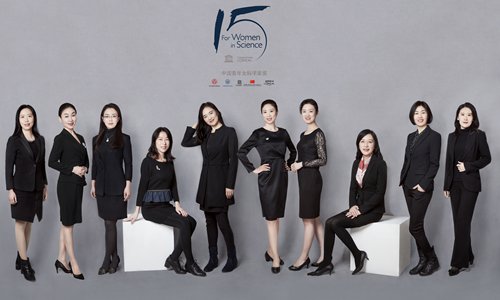
The 10 winners of the 15th China Young Women Scientists Awards (Photo: Courtesy of L'Oréal China)
China is helping female scientists empower themselves, and taking steps more quickly to bring about equality between men and women in the field of scientific research, a dozen Chinese female scientists said at a top award ceremony that honored outstanding Chinese women in science and technology.
"Being a mother and a scientist at the same time is a difficult path. But now, I am more comfortable with it. I think about my research while I'm driving my child to school. Children and family are not always your obstacles. It's about whether you are brave enough to persevere as a female scientific researcher," Niu Shuli told the Global Times.
She won the award with nine others for her outstanding research into the ecosystem.
On April 29, the 15th China Young Women Scientists Awards ceremony, jointly organized by the All-China Women's Federation, China Association for Science and Technology, Chinese National Commission for UNESCO and L'Oréal China, was held at the National Museum.
Ten women with outstanding achievements in medical, biological, ecology and aerospace sciences were selected for awards from 224 candidates.
Niu calls on female scientists to maintain their tenacity and stamina in response to China's continuous efforts to create a more equal and inclusive environment for female researchers. Her speech at the award ceremony drew enthusiastic applause.
She brought all of her female research fellows and students into her project group, taking the opportunity to encourage them to keep going forward.
The award, established in 2004, extended the L'Oréal-UNESCO international awards for women in science into China.
It aims to bring attention to and support female scientists and technicians, as well as encourage and attract more women to take part in scientific and technological innovation.
"The special award for women scientists underlines their importance, although I might have been happier if I won the prize not for my female identity," said Ma Yuting, one of the winners, "But we are thankful for the recognition, which tells us that we are making academic achievements that contribute to humanity while creating the next generation of life for this society."
In recent years, great progress in gender parity has been made in the arena of science, empowering women to overcome difficult challenges in the industry. China is embracing female scientists in a more open and inclusive way.
Traditional barriers
The glass ceiling for female scientists has long been a global problem, and China is no exception.
Figures show that only 5 percent of academicians from the Chinese Academy of Sciences and the Chinese Academy of Engineering were women in 2017. Among the winners of the "Yangtze River Scholar" title, one of China's highest academic honors given to scholars from across the world, only 3.9 percent are women.
Not one woman was included in the national 863 Program, which is focused on developing key technologies in agriculture, pharmaceuticals, and other related areas.
"Taking my major, biology, as an example, the proportion of male and female students is seriously unbalanced, with female students accounting for almost two-thirds. However, after graduation, the number of male students that are able to continue to engage in biology and ecology research is far higher than female students," said Ma.
Media reports and data have repeatedly shown gender inequality in the laboratory, and how physiological barriers can drive young women away from their academic research.
But this situation now seems to be making a change for the better.
Opportunity and expectation
Nature, a British multidisciplinary scientific journal, praises the efforts of Chinese research institutions, referring to the example of the National Natural Science Foundation of China (NSFC).
Taking into account women's roles as mothers, the institution extended age limits for female grant applicants in 2011 from 35 to 40, while that for men remained at 35.
This led to a sharp increase in the number of female researchers applying for grants.
"Women in China have one of the highest rates of participation in the labor force when compared with women from both large developed and emerging economies, such as the United States, Germany, Brazil and India," said Nature, claiming "it is a legacy of its planned-economy era, starting in 1949, when women's participation in the workforce was encouraged and protected."
Female scientists are now more able to break away from the traditionally ingrained nature of gender discrimination against them, the female winners told the Global Times, acknowledging that they are receiving more respect and protection in their field. They deny that the gap is widening or that the barriers are impossible to conquer.
At present, China is clearly establishing its own research, development and innovation system, with its researchers increasing from 3.2 million in 2009 to 5.8 million in 2016, Science and Technology Daily reported. The demand for talents highlights the need for more female scientists.
At the same time, China is accelerating efforts to address concerns over gender inequality in science and technology.
"In some US research institutions, there is a regulation stipulating that an academic conference has to guarantee at least 30 percent attendance by women, otherwise they will not receive sponsorship," Niu told the Global Times. "That effectively resolved the gender imbalance. Similar moves are expected in the future in China."


